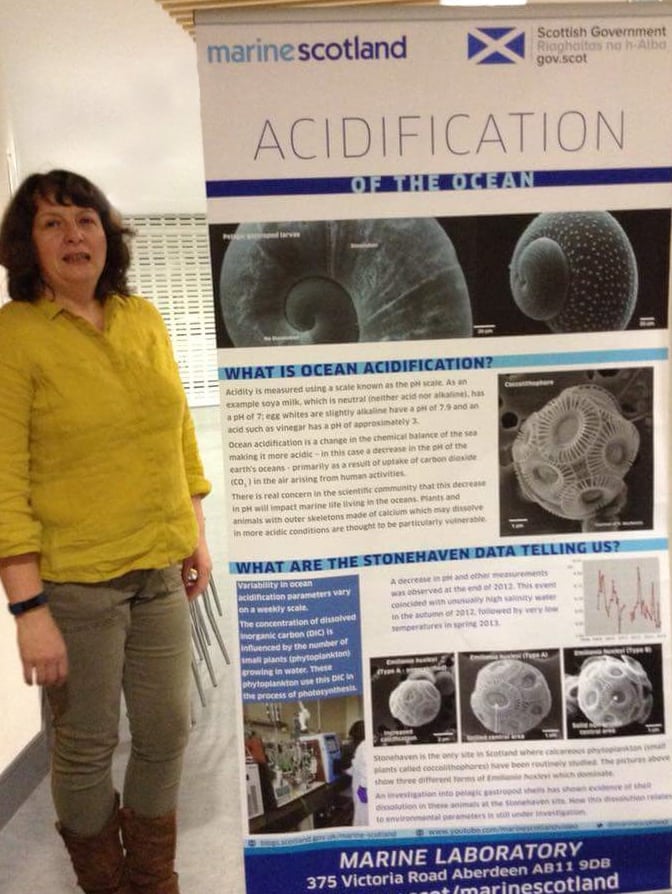Marine
Celebrating Science and Year of the Young Person with Pam Walsham
March 22, 2018 by Marine Directorate Communications No Comments | Category Marine Directorate Science, Science, Technology, Engineering, Maths_STEM, Year of the Young Person
2018 is both the Year of the Engineer and the Year of the Young Person and this blog is about one of our many colleagues who are inspiring the next generation with their Outreach work.
Enjoys chemistry, outreach work and ice cream, meet Pam Walsham, a senior environmental chemist, at Marine Scotland Science. Please read on to find out more!
Who are you and what do you do?
My name is Pam Walsham and I am a Senior Environmental Chemist in Marine Scotland Science (MSS) Environment Monitoring and Assessment Group. I am interested in chemistry and the marine environment of the sea. My main role is to manage the water chemistry monitoring and research projects providing data on nutrients, dissolved oxygen, chlorophylls and ocean acidification parameters. I also represent MSS on a number of national and international groups covering anything from quality control to providing advice and guidance.
Why is what you do important?
The data we produce feeds into environmental status assessments both nationally and internationally. Scientists use this data to assess current status, understand processes and help predict potential impacts under future climate scenarios. An area of particular concern is the impact of increasing carbon dioxide (CO2) concentrations, caused by human activities, in the atmosphere. CO2 naturally exchanges between the atmosphere and our oceans and seas. However, the increase in atmospheric CO2 is resulting in more CO2 being absorbed by our oceans which then changes the chemistry of the water lowering its pH. This lowering of the seawaters pH is known as ocean acidification. Scientists believe changing the acidity of sea water may have an impact on many living organisms in the sea, as well as processes that effect such things as the creation of new sediment. We need to know what is happening currently in the sea to try and predict what could happen under predicted future atmospheric CO2 concentrations.
What’s your career path been – how did you get here?
I left school at 17 and started working as an Assistant Scientific Officer at Ministry Agriculture Fisheries and Food (MAFF) Torry Research Station (TRS) in Aberdeen. For the first few years I attended college on day release similar to the modern day apprenticeships. I often did work in conjunction with the Marine Laboratory with several trips on the old black and yellow Scotia. Over the years I have worked in the fields of organic contaminants (hydrocarbons, PCBs, perfluorinated flame retardants) lipid analysis and water chemistry. This has involved using a wide range of analytical techniques including; high performance thin layer chromatography (HP-TLC), Fourier transform infra red spectroscopy (FT-IR), ultra violet fluorescence (UVF) spectroscopy, ion exchange chromatography, high performance liquid chromatography (HPLC), gel permeation chromatography (GPC), continuous flow analysers for nutrient analysis, gas chromatography (GC) and mass spectrometry (MS) and liquid chromatography (LC)-MS.
If you weren’t doing this, what do you think you’d be doing instead?
I wanted to be a Forensic Scientist or a medical examiner. It all started with watching the 70’s TV show Quincy I love the idea of using the science to work out how crimes are solved, nothing much has changed but now it’s NCIS I watch.
What’s your favourite fishy fact?
The pearl essence which comes from fish scales is used in animal-based lipstick colours.
What about one fun fact about you?
I have completed the Stenness Monster Challenge. What is this? Well it is a very large cone filled with seven scoops of Orkney ice-cream. You can choose a single flavour of ice-cream or mix and match You have to eat the ice cream and the cone within an hour to complete the challenge and then your name is recorded. Want to try? You have to go to Gerri’s Ice Cream Parlour in Orkney for this!
What made you decide to be involved with Outreach?
I started getting involved with Outreach when my son was at primary school and they were looking for someone to come along and talk to the primary 2s about science. I invited a colleague who was involved in outreach to the event and I ended up helping him. We had the children dressing up as scientists in boiler suits, white coats and all sorts of fun things. The children loved it and I was hooked!
What do you enjoy most about doing Outreach?
Generally engaging with public explaining what we do and why, but the most rewarding has to be working with children. It is great to watch how the younger children are fascinated by everything we do being little sponges absorbing everything and then asking the awkward questions.
Would you encourage others to get involved?
Just do it as it is so rewarding to be engaged with the public and getting them interested. Making science fun and interesting for children is fantastic as they are the scientist of the future who will carry on our work.
Further Information



Leave a comment